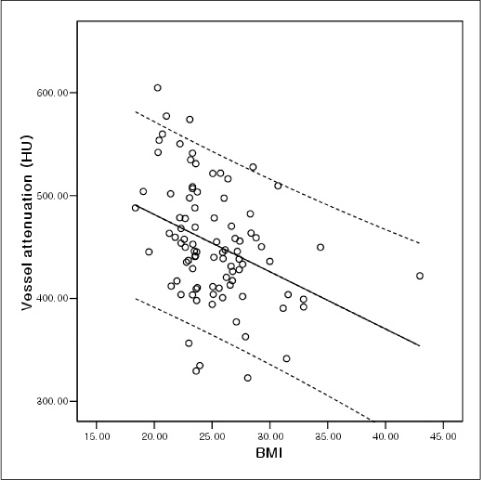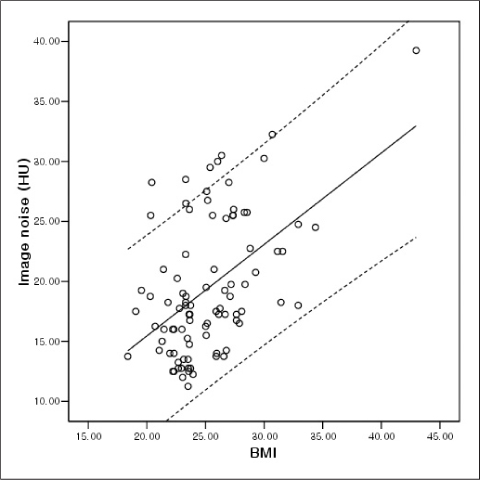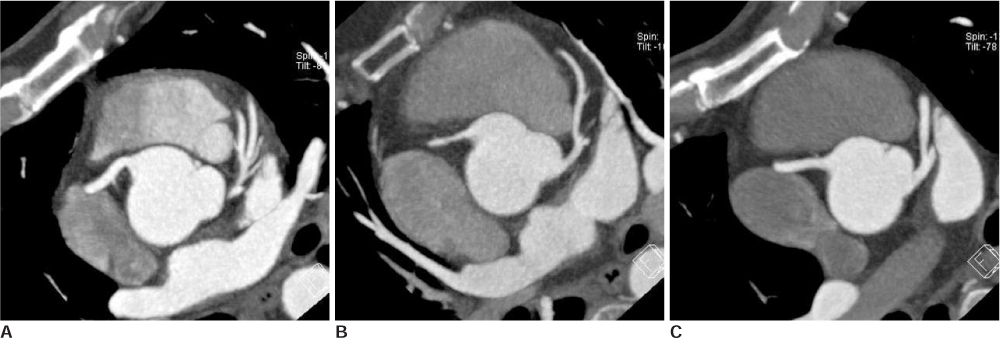J Korean Soc Radiol.
2010 Jan;62(1):29-35. 10.3348/jksr.2010.62.1.29.
Image Quality and Radiation Exposure in Coronary CT Angiography According to Tube Voltage and Body Mass Index
- Affiliations
-
- 1Department of Radiology, Korea University Guro Hospital, Korea University College of Medicine, Korea.
- 2Department of Radiology, Ewha Womans University MokDong Hospital, Korea. yookkim@ewha.ac.kr
- KMID: 2208991
- DOI: http://doi.org/10.3348/jksr.2010.62.1.29
Abstract
- PURPOSE
To investigate the image quality and radiation dose of a coronary CT angiography (CCTA) according to tube voltage and body mass index (BMI).
MATERIALS AND METHODS
This study included 139 patients who underwent CCTA using a retrospective electrocardiography- gating technique. A total of 48 patients (BMI <2 5, group A) were examined with 100 kVp, 45 patients (BMI > 25, group B) with 120 kVp, and 46 patients (BMI < 25, group C) with 120 kVp. Attenuation and image noise of the aorta and coronary arteries was measured. Moreover, the image quality of 9 coronary segments was graded on a scale of 1-5, where grade 4 or 5 was considered to be diagnostic. Image quality parameters and radiation dose were compared using a t-test or Chi-squared test.
RESULTS
Vessel attenuation in group A was significantly higher than in groups B or C (group A, 592 +/- 85 HU; group B, 437 +/- 46 HU; group C, 469 +/- 62 HU, p<0.001). Image noise was similar in group A and group B (23 +/- 5 HU versus 22 +/- 6 HU, p=0.427), but significantly higher in group A compared to group C (23 +/- 5 HU versus 17 +/- 4 HU, p<0.001). A significant difference was observed in the signal-to-noise ratio between the three groups (group A, 24 +/- 6; group B, 19 +/- 3; group C, 27 +/- 5: p<0.05). Moreover, the contrast-to-noise ratio was significantly higher in group A than group B (group A 18 +/- 5 versus group B 14 +/- 3, p < 0.001) but not significantly different between group A and group C (group C 20 +/- 4, p=0.127). The percentage of coronary segments with diagnostic image quality was 97.9% in group A, 96.0% in group B, and 99.0% in group C. The mean image quality score was 4.5 +/- 0.5 in group A, 4.1 +/- 0.4 in group B, and 4.2 +/- 0,4 in group C (p<0.001). The effective radiation doses were 8.5 +/- 0.8 mSv in group A, 14.3 +/- 1.3 mSv in group B, and 14.9 +/- 1.3 mSv in group C. A 42% reduction in mean effective radiation dose in group A was observed compared with groups B and C.
CONCLUSION
In patients with BMI less than 25 and a low-dose CCTA with 100 kVp leads to a significant reduction in radiation exposure without degradation of image quality.
MeSH Terms
Figure
Reference
-
1. Mollet NR, Cademartiri F, van Mieghem CA, Runza G, McFadden EP, Baks T, et al. High-resolution spiral computed tomography coronary angiography in patients referred for diagnostic conventional coronary angiography. Circulation. 2005; 112:2318–2323.2. Leschka S, Alkadhi H, Plass A, Desbiolles L, Grünenfelder J, Marincek B, et al. Accuracy of MSCT coronary angiography with 64-slice technology: first experience. Eur Heart J. 2005; 26:1482–1487.3. Husmann L, Schepis T, Scheffel H, Gaemperli O, Leschka S, Valenta I, et al. Comparison of diagnostic accuracy of 64-slice computed tomography coronary angiography in patients with low, intermediate, and high cardiovascular risk. Acad Radiol. 2008; 15:452–461.4. Hausleiter J, Meyer T, Hadamitzky M, Huber E, Zankl M, Martinoff S, et al. Radiation dose estimates from cardiac multislice computed tomography in daily practice: impact of different scanning protocols on effective dose estimates. Circulation. 2006; 113:1305–1310.5. Leschka S, Stolzmann P, Schmid FT, Scheffel H, Stinn B, Marincek B, et al. Low kilovoltage cardiac dual-source CT: attenuation, noise, and radiation dose. Eur Radiol. 2008; 18:1809–1817.6. Szucs-Farkas Z, Kurmann L, Strautz T, Patak MA, Vock P, Schindera ST. Patient exposure and image quality of low-dose pulmonary computed tomography angiography: comparison of 100-and 80-kVp protocols. Invest Radiol. 2008; 43:871–876.7. Stolzmann P, Leschka S, Scheffel H, Krauss T, Desbiolles L, Plass A, et al. Dual-source CT in step-and-shoot mode: noninvasive coronary angiography with low radiation dose. Radiology. 2008; 249:71–80.8. Alkadhi H, Stolzmann P, Scheffel H, Desbiolles L, Baümuller S, Plass A, et al. Radiation dose of cardiac dual-source CT: the effect of tailoring the protocol to patient-specific parameters. Eur J Radiol. 2008; 68:385–391.9. Tatsugami F, Husmann L, Herzog BA, Burkhard N, Valenta I, Gaemperli O, et al. Evaluation of a body mass index-adapted protocol for low-dose 64-MDCT coronary angiography with prospective ECG triggering. AJR Am J Roentgenol. 2009; 192:635–638.10. Jung B, Mahnken AH, Stargardt A, Simon J, Flohr TG, Schaller S, et al. Individually weight-adapted examination protocol in retrospectively ECG-gated MSCT of the heart. Eur Radiol. 2003; 13:2560–2566.11. Irie T, Inoue H. Individual modulation of the tube current-seconds to achieve similar levels of image noise in contrast-enhanced abdominal CT. AJR Am J Roentgenol. 2005; 184:1514–1518.12. Bae KT, Seeck BA, Hildebolt CF, Tao C, Zhu F, Kanematsu M, et al. Contrast enhancement in cardiovascular MDCT: effect of body weight, height, body surface area, body mass index, and obesity. AJR Am J Roentgenol. 2008; 190:777–784.13. Pflederer T, Rudofsky L, Ropers D, Bachmann S, Marwan M, Daniel WG, et al. Image quality in a low radiation exposure protocol for retrospectively ECG-gated coronary CT angiography. AJR Am J Roentgenol. 2009; 192:1045–1050.14. Sigal-Cinqualbre AB, Hennequin R, Abada HT, Chen X, Paul JF. Low-kilovoltage multi-detector row chest CT in adults: feasibility and effect on image quality and iodine dose. Radiology. 2004; 231:169–174.15. Nakayama Y, Awai K, Funama Y, Hatemura M, Imuta M, Nakaura T, et al. Abdominal CT with low tube voltage: preliminary observations about radiation dose, contrast enhancement, image quality, and noise. Radiology. 2005; 237:945–951.
- Full Text Links
- Actions
-
Cited
- CITED
-
- Close
- Share
- Similar articles
-
- A Comparative Study of Image Quality and Radiation Dose with Changes in Tube Voltage and Current for a Digital Chest Radiography
- Evaluation of a Chest Circumference-Adapted Protocol for Low-Dose 128-Slice Coronary CT Angiography with Prospective Electrocardiogram Triggering
- Tube Voltage, DNA Double-Strand Breaks, and Image Quality in Coronary CT Angiography
- Effects of Iterative Reconstruction Algorithm, Automatic Exposure Control on Image Quality, and Radiation Dose: Phantom Experiments with Coronary CT Angiography Protocols
- Feasibility Study of Radiation Dose Reduction in Adult Female Pelvic CT Scan with Low Tube-Voltage and Adaptive Statistical Iterative Reconstruction




